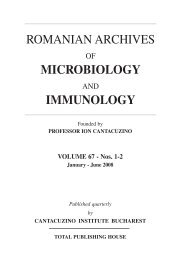Interior Archives_1(2013)_000pag_2-6 - RAMI Editorial Board
Interior Archives_1(2013)_000pag_2-6 - RAMI Editorial Board
Interior Archives_1(2013)_000pag_2-6 - RAMI Editorial Board
Create successful ePaper yourself
Turn your PDF publications into a flip-book with our unique Google optimized e-Paper software.
VLADIMIR F. NICULESCU<br />
at 4°C (up to 30 days). Opsonized bacterial cells<br />
are added for the Aa(Sm) culture medium which<br />
is now ready for growing amoebae. En- and excystment<br />
experiments were started with freshly<br />
harvested bacteria.<br />
Inoculum<br />
The culture was carried out in 10 ml centrifuge<br />
glass U-tubes containing 5 ml of CM, 5<br />
mg of A. aerogenes AH8 bacteria and 0.5 or 1.0<br />
x 10 6 amoebae. The bacteria were inhibited by<br />
a combination of streptomycin and erythromycin.<br />
After addition of the amoeba inoculants, the<br />
tubes were centrifuged at 1,000 rpm to gently<br />
form a solid breeding sediment on the tube bottom<br />
and incubated at 28°C. The antibiotic-repressed<br />
bacterial mass provides the redox<br />
environments for optimal amoebic growth.<br />
Amoe bae consumed bacteria in the sediment.<br />
The medium remained transparent. Bacterial superinfections<br />
producing opacity and precipitation<br />
were therefore easy to detect. Aa(Sm)-CM<br />
supports ex-cystment, growth and cyclic encystment<br />
of E. invadens. All work was performed<br />
under sterile conditions.<br />
Quantitative analysis<br />
The size of the amoeba population was determined<br />
using a hematologic counting chamber.<br />
All cell counts were performed under microscope.<br />
Cysts were identified visually. In order to<br />
evaluate the population density of amoebae the<br />
contents of a culture tube needed to be homogenized<br />
by stirring. The contents of culture tubes<br />
(culture sediment and liquid) were mechanically<br />
homogenized by stirring and sucked up and<br />
down using a sterile 2 ml glass pipette. The contents<br />
of the culture tubes were thus also aerated.<br />
This is a serious problem as evaluation of each<br />
culture altered the redox environment and influenced<br />
later development in the Aa(Sm) culture.<br />
The effects of changing redox status due to the<br />
aeration caused by the first measurement were<br />
examined, by taking a second measurement at a<br />
later point. After sampling, the culture sediment<br />
was recovered by centrifugation. Later to minimize<br />
the impact of counting on population kinetics,<br />
many duplicate samples were started in<br />
parallel, each of which may be examined only<br />
once, then discarded.<br />
RESULTS<br />
Culture sediments with oxygen consu -<br />
ming bacteria provided optimal hypoxic<br />
conditions for growth and development of<br />
E. invadens<br />
Work previous to this study showed that E.<br />
invadens preferred low oxygen levels and opsonized<br />
A.aerogenes. Aminoglycosides such as<br />
streptomycin and macrolides such as erythromycin<br />
added in moderate doses to the Aa(Sm)<br />
stopped bacterial growth by inhibiting protein<br />
synthesis. The advantage of the Aa(Sm) sediment<br />
culture is the hypoxic dynamics occurring<br />
during the interplay between the antibiotically<br />
regulated bacteria and the phagocytic amoebae.<br />
Amoebae consume the bacteria by predation reversing<br />
the hypoxia. The initial consumption of<br />
oxygen by the bacteria and the subsquent consumption<br />
of the bacteria by the growing amoeba<br />
modulate the hypoxic conditions causing chan -<br />
ges in growth phases and development in E. invadens<br />
(Fig. 1). The large number of bacteria at<br />
the beginning of growth and the rapid oxygen<br />
depletion in the early initiation phase (0-2 h) induce<br />
mitotically active cells. During the growth<br />
phase (4-72 h) when amoebae feed on the oxygen<br />
consuming bacteria from the culture sediment,<br />
hypoxia is gradually reversed. As opposed<br />
to axenic culture media the environmental<br />
changes occuring in the Aa(Sm) culture, mimic<br />
the extracellular signaling from natural habitats<br />
and reveal new insights concerning growth, cell<br />
cycle and multicellularity in developmental<br />
populations of E. invadens.<br />
Growth and differentiation<br />
The initiation phase (0 - 4 h)*. The initiation<br />
phase begins at t0 and ends at t4 when<br />
amoebic population has doubled. In the early<br />
initiation phase (0-2 h) dissolved oxygen in the<br />
sediment is consumed rapidly by the bacteria.<br />
Mitotic activators cause all passaged cells to reenter<br />
and continue the cell cycle. In the late subphase<br />
(2-4 h) amoeba make the first asymmetric<br />
cell division;<br />
The growth phase I (5 - ca 30 h) * . With<br />
continuing growth the amoeba population increases<br />
and the bacteria are consumed decreasing<br />
their population. 28 - 30 h after culture<br />
*<br />
The duration of individual stages of growth indicates average time periods<br />
28



